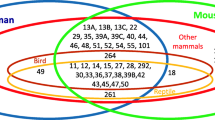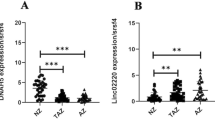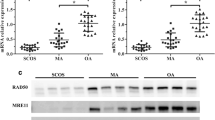Abstract
The CDY family of genes is of special interest because some of them are included in chromosome-Y microdeletions detected among infertile men and are apparently involved in the spermiogenetic process. In this study, we employed the reverse transcriptase/polymerase chain reaction technique to test the RNA expression of the various transcripts of these genes in testicular biopsies of 84 azoospermic men who had been classified by comprehensive histology and cytology analyses. We also evaluated the feasibility of detecting CDY expression in biopsies taken by testicular sperm extraction versus acquisition by aspiration. There was a significant association between the type of testicular impairment and the expression of CDY1 and CDY2 transcripts. CDY2 was expressed whenever germ cells were present, but CDY1 major and especially CDY1 minor and short transcripts were identified almost exclusively when mature spermatids/spermatozoa were detected. The expression of CDY1 minor and short transcripts detected in aspirated specimens was less efficient than that in testicular tissue acquired by extraction. It is sugested that CDY2 is apparently required in the early stages of spermatogenesis, whereas CDY1 transcripts are required later on in the process. The findings of this study imply different functional roles for CDY isoforms during spermatogenesis. However, in consideration of the high levels of identity between CDY1 and CDY2 (98% at the protein level), the delayed up-regulation of CDY1 transcripts could be attributable to temporal changes in dosage requirements.



Similar content being viewed by others
References
Bar-Shira Maymon B, Elliott DJ, Kleiman SE, Yogev L, Hauser R, Botchan A, Schreiber L, Cooke HJ, Paz G, Yavetz H (2001) The contribution of RNA-binding motif (RBM) antibody to the histopathologic evaluation of testicular biopsies from infertile men. Hum Pathol 32:36–41
Ben-Yosef D, Yogev L, Hauser R, Hauser R, Yavetz H, Azem F, Yovel I, Lessing JB, Amit A (1999) Testicular sperm retrieval and cryopreservation prior to initiating ovarian stimulation as the first line approach in men with non-obstructive azoospermia. Hum Reprod 14:1794–1801
Eddy EM (1998) Regulation of gene expression during spermatogenesis. Semin Cell Dev Biol 9:451–457
Edwards RG, Bishop CE (1997) On the origin and frequency of the Y chromosome deletions responsible for severe male infertility. Mol Hum Reprod 3:549–554
Elliott DJ, Oghene K, Makarov G, Makarova O, Hargreave TB, Chandley AC, Eperon IC, Cooke HJ (1998) Dynamic changes in the subnuclear organization of pre-mRNA splicing proteins and RBM during human germ cell development. J Cell Science 111:1255–1265
Elliott DJ, Bourgeois CF, Klink A, Stevenin J, Cooke HJ (2000) A mammalian germ cell-specific RNA-binding protein interacts with ubiquitously expressed proteins involved in splice site selection. Proc Natl Acad Sci USA 97:5717–5722
Ezeh UI, Moore HD, Cooke ID (1998) A prospective study of multiple needle biopsies versus a single open biopsy for testicular sperm extraction in men with non-obstructive azoospermia. Hum Reprod 13:3075–3080
Friedler S, Raziel A, Strassburger D, Soffer Y, Komarovsky D, Ron-El R (1997) Testicular sperm retrieval by percutaneous fine needle sperm aspiration compared with testicular sperm extraction by open biopsy in men with non-obstructive azoospermia. Hum Reprod 12:1488–1493
Hauser R, Botchan A, Amit A, Ben Yosef D, Gamzu R, Paz G, Lessing JB, Yogev L, Yavetz H (1998) Multiple testicular sampling in non-obstructive azoospermia—is it necessary? Hum Reprod 13:3081–3085
Hazzouri M, Pivot-Pajot C, Faure AK, Usson Y, Pelletier R, Sele B, Khochbin S, Rousseaux S (2000) Regulated hyperacetylation of core histones during mouse spermatogenesis: involvement of histone deacetylases. Eur J Cell Biol 79:950–960
Kleene KC (2001) A possible meiotic function of the peculiar patterns of gene expression in mammalian spermatogenic cells. Mech Dev 106:3–23
Kleiman SE, Yogev L, Gamzu R, Hauser R, Botchan A, Lessing JB, Paz G, Yavetz H (1999) Genetic evaluation of infertile men. Hum Reprod 14:33–38
Kleiman SE, Lagziel A, Yogev L, Botchan A, Paz G, Yavetz H (2001) Expression of CDY1 may identify complete spermatogenesis. Fertil Steril 75:166–173
Kobayashi, K, Mizuno K, Hida A, Komaki R, Tomita K, Matsushita I, Namiki M, Iwamoto T, Tamura S, Minowada S (1994) PCR analysis of the Y chromosome long arm in azoospermic patients: evidence for a second locus required for spermatogenesis. Hum Mol Genet 3:1965–1967
Kostova E, Rottger S, Schempp W, Gromoll J (2002) Identification and characterization of the cynomolgus monkey chromodomain gene cynCDY, an orthologue of the human CDY gene family. Mol Hum Reprod 8:702–709
Kuroda-Kawaguchi T, Skaletsky H, Brown LG, Minx PJ, Cordum HS, Waterston RH, Wilson RK, Silber S, Oates R, Rozen S, Page DC (2001) The AZFc region of the Y chromosome features massive palindromes and uniform recurrent deletions in infertile men. Nat Genet 29:279–286
Lahn BT, Page DC (1997) Functional coherence of the human Y chromosome. Science 278:675–680
Lahn BT, Page DC (1999) Retroposition of autosomal mRNA yielded testis-specific gene family on human Y chromosome. Nat Genet 21:429–433
Lahn BT, Tang ZL, Zhou J, Barndt RJ, Parvinen M, Allis CD, Page DC (2002) Previously uncharacterized histone acetyltransferases implicated in mammalian spermatogenesis. Proc Natl Acad Sci USA 99:8707–8712
Lee JH, Lee DR, Yoon SJ, Chai YG, Roh SI, Yoon HS (1998) Expression of DAZ (deleted in azoospermia), DAZL1 (DAZ-like) and protamine-2 in testis and its application for diagnosis of spermatogenesis in non-obstructive azoospermia. Mol Hum Reprod 4:827–834
Lewin A, Reubinoff B, Porat-Katz A, Weiss D, Eisenberg V, Arbel R, Bar-el H, Safran A (1999) Testicular fine needle aspiration: the alternative method for sperm retrieval in non-obstructive azoospermia Hum Reprod 14:1785–1790
Ma K, Inglis JD, Sharkey A, Bickmore WA, Hill RE, Prosser EJ, Speed RM, Thomson EJ, Jobling M, Taylor K (1993) A Y chromosome gene family with RNA-binding protein homology: candidates for the azoospermia factor AZF controlling human spermatogenesis. Cell 75:1287–1295
Menke DB, Mutter GL, Page DC (1997) Expression of DAZ, an azoospermia factor candidate, in human spermatogonia. Am J Hum Genet 60:237–241
Meistrich ML, Trostle-Weiga PK, Lin R, Bhatnagar YM, Allis CD (1992) Highly acetylated H4 is associated with histone displacement in rat spermatids. Mol Reprod Dev 31:170–181
Oates RD, Silber S, Brown LG, Page DC. (2002) Clinical characterization of 42 oligospermic or azoospermic men with microdeletion of the AZFc region of the Y chromosome, and of 18 children conceived via ICSI. Hum Reprod 17:2813–2824
Pryor JL, Kent-First M, Muallem A, Van Bergen AH, Nolten WE, Meisner L, Roberts KP (1997) Microdeletions in the Y chromosome of infertile men. N Engl J Med 336:534–539
Reijo R, Lee TY, Alagappan R, Brown LG, Rosenberg M, Rozen S, Jaffe T, Straus D, Hovatta O, Chapelle A de la, Silver S, Page DC (1995) Diverse spermatogenic defects in humans caused by Y chromosome deletions encompassing a novel RNA-binding protein gene. Nat Genet 10:383–392
Repping S, Skaletsky H, Lange J, Silber S, Van Der Veen F, Oates RD, Page DC, Rozen S (2002) Recombination between palindromes P5 and P1 on the human Y chromosome causes massive deletions and spermatogenic failure. Am J Hum Genet 71:906–922
Schrader M, Muller M, Schulze W, Heicappell R, Krause H, Straub B, Miller K (2002a) Quantification of the expression level of the gene encoding the catalytic subunit of telomerase in testicular tissue specimens predicts successful sperm recovery. Hum Reprod 17:150–156
Schrader M, Muller-Tidow C, Ravnik S, Muller M, Schulze W, Diederichs S, Serve H, Miller K (2002b) Cyclin A1 and gametogenesis in fertile and infertile patients: a potential new molecular diagnostic marker. Hum Reprod 17:2338–2343
Silber SJ, Nagy S, Devroey P, Tournaye H, Van Steirteghem AC (1997) Distribution of spermatogenesis in the testicles of azoospermic men: the presence or absence of spermatids in the testes of men with germinal failure. Hum Reprod 12:2422–2428
Tiepolo L, Zuffardi O (1976) Localization of factors controlling spermatogenesis in the nonfluorescent portion of the human Y chromosome long arm. Hum Genet 34:119–124
Vogt PH, Edelmann A, Kirsch S, Henegariu O, Hirschmann P, Kiesewetter F, Kohn FM, Schill WB, Farah S, Ramos C, Hartmann M, Hartschuh W, Meschede D, Behre HM, Castel A, Nieschlag E, Weidner W, Grone HJ, Jung A, Engel W, Haidl G (1996) Human Y chromosome azoospermia factors (AZF) mapped to different subregions in Yq11. Hum Mol Genet 5:933–943
Acknowledgments
The authors thank Tovi Morad for her excellent technical assistance, Esther Eshkol for editorial assistance, and Ilana Galernter (Statistical Department, Tel Aviv University) for expert statistical analysis. The Chief Scientific Office, Ministry of Health, Israel (grant no. 4823) supported this study.
Author information
Authors and Affiliations
Corresponding author
Additional information
An erratum to this article can be found at http://dx.doi.org/10.1007/s00439-003-1067-5
Rights and permissions
About this article
Cite this article
Kleiman, S.E., Yogev, L., Hauser, R. et al. Members of the CDY family have different expression patterns: CDY1 transcripts have the best correlation with complete spermatogenesis. Hum Genet 113, 486–492 (2003). https://doi.org/10.1007/s00439-003-0990-9
Received:
Accepted:
Published:
Issue Date:
DOI: https://doi.org/10.1007/s00439-003-0990-9




